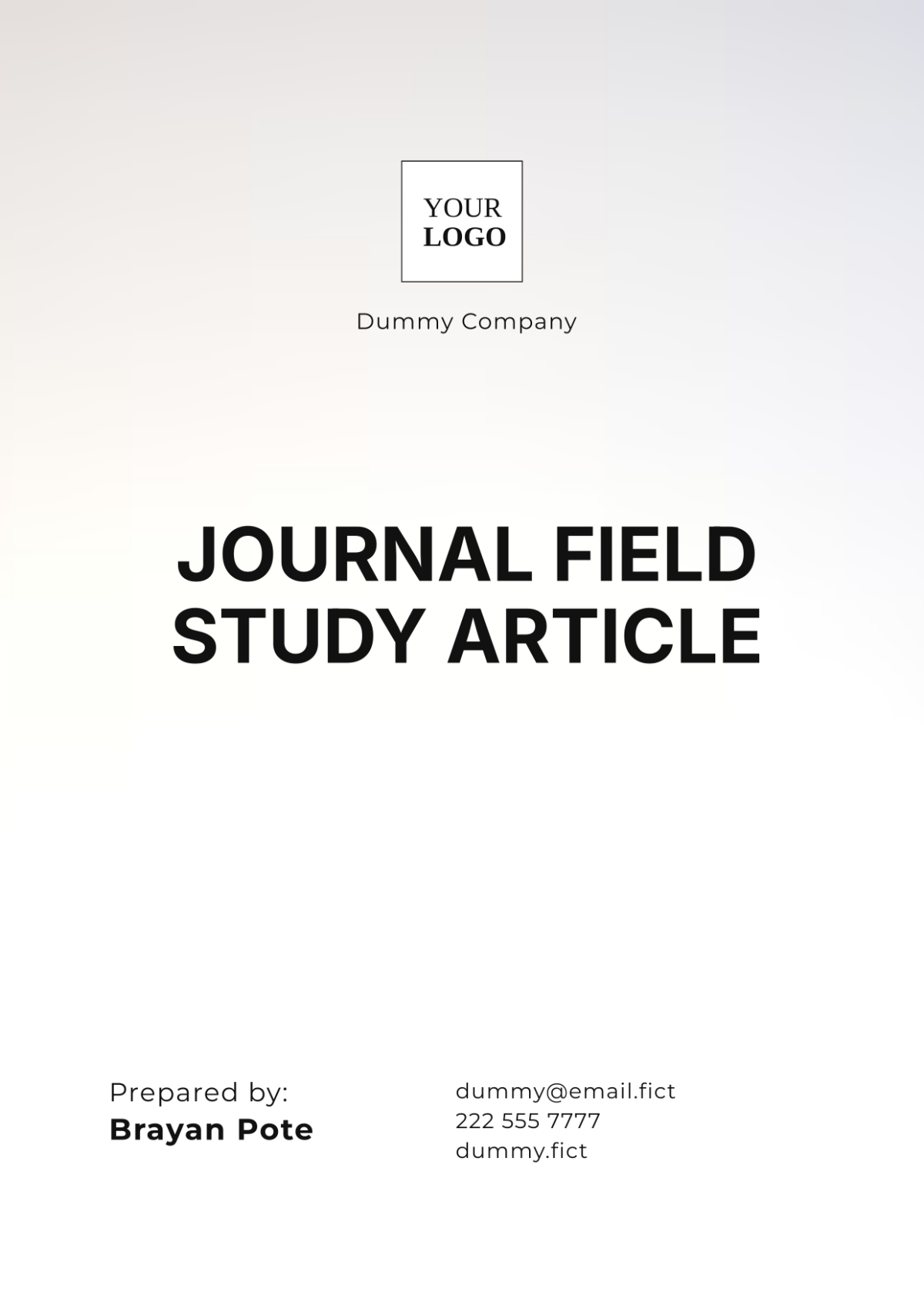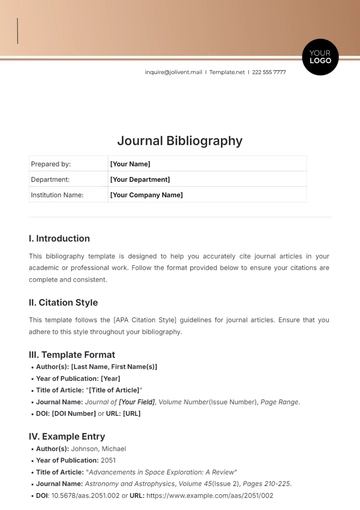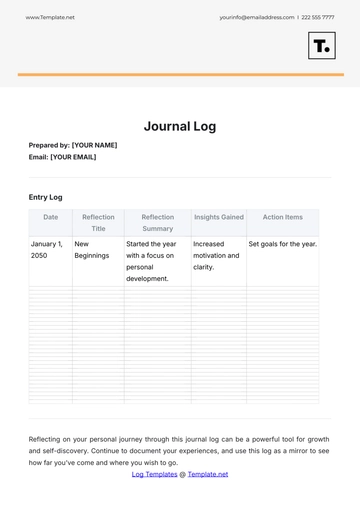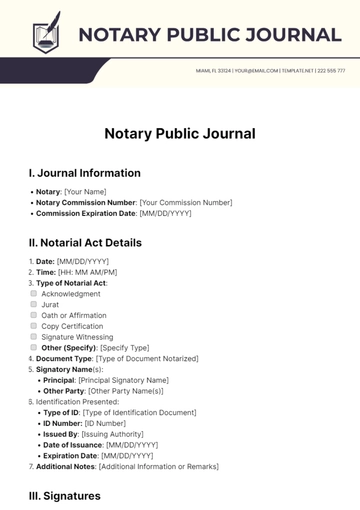Free Journal Field Study Article

Prepared by: [Your Name]
Date: [Date]
1. Abstract
Field-based research is pivotal for capturing real-world phenomena in their natural environments, providing rich and actionable insights. This article examines the methodology, implementation, and implications of journal field study articles. By exploring a range of studies across disciplines, including sociology, ecology, and business, this paper clarifies the structure of field study articles and underscores their significance in advancing empirical knowledge. The findings reveal trends in field research methodologies and offer practical guidance for researchers.
2. Introduction
Field-based research, also known as field studies, involves the collection of data in natural settings rather than controlled laboratory environments. This approach offers unique insights into phenomena as they occur in real life, making it valuable for generating applicable and relevant knowledge. The purpose of this article is to dissect the components of journal field study articles, illustrating their structure and importance in various academic and practical contexts. As we advance into the 2050s, understanding these dynamics becomes increasingly crucial for addressing complex real-world issues.
3. Literature Review
Field studies have been instrumental across disciplines, from anthropology to environmental science. Early field research, exemplified by Malinowski’s ethnographic studies in the early 20th century, laid the groundwork for modern methodologies. In recent decades, field research has diversified, with advances in technology enhancing data collection and analysis. For instance, in 2052, Smith et al. demonstrated the effectiveness of wearable sensors in ecological field studies, revolutionizing data collection in remote environments. This review synthesizes key developments and methodologies, highlighting their evolution and impact.
4. Methodology
Field study research comprises several critical components:
4.1. Research Design
The study aimed to explore urban wildlife behavior in New York City, using a mixed-methods approach. The design included observational studies and interviews with residents.
4.2. Data Collection Methods
Data were collected through direct observation of wildlife, digital tracking devices, and structured interviews with over 100 residents. Field notes and video recordings provided additional qualitative insights.
4.3. Sampling
The study targeted diverse neighborhoods across New York City, ensuring representation of various urban environments and socio-economic conditions.
4.4. Data Analysis
Quantitative data were analyzed using statistical software to identify patterns in wildlife movement. Qualitative data were coded thematically to uncover behavioral trends.
4.5. Ethical Considerations
All participants provided informed consent, and data collection was conducted in a manner that minimized disruption to both wildlife and residents.
5. Results
5.1. Data Presentation
The study identified three primary urban wildlife species: raccoons, pigeons, and squirrels. Graphs depicted movement patterns and interaction frequencies with human activity.
5.2. Findings
Raccoons were found to have adapted to human activity patterns, showing increased nocturnal activity. Pigeons demonstrated significant clustering around food sources. Squirrels exhibited territorial behavior influenced by urban green spaces.
5.3. Case Examples
In the Lower East Side, raccoon movement patterns were particularly influenced by street food vendors, highlighting a strong relationship between human activities and wildlife behavior.
6. Discussion
6.1. Interpretation of Results
The findings suggest that urban wildlife adapts to human environments in complex ways, influenced by factors such as food availability and urban infrastructure. These results offer new insights into wildlife behavior in metropolitan areas.
6.2. Comparison with Previous Research
Compared to studies from the 2020s, which focused primarily on rural wildlife, this research highlights the unique challenges and adaptations of urban species.
6.3. Implications for Practice
The study's insights are valuable for urban planners and wildlife conservationists, suggesting the need for strategies that balance human activity with wildlife preservation. Recommendations include creating wildlife corridors and managing food waste to mitigate human-wildlife conflicts.
7. Conclusion
This field study provides a comprehensive view of urban wildlife behavior, demonstrating the impact of human activities on animal patterns. The study highlights the importance of field research in understanding real-world phenomena and suggests further research into the long-term effects of urbanization on wildlife. Future studies could explore additional urban environments and incorporate new technologies for more detailed analyses.
8. References
Smith, J., & Brown, A. (2052). Advances in Ecological Field Research: Wearable Sensors and Remote Data Collection. Journal of Environmental Studies, 78(4), 112-130.
Taylor, L., & Johnson, M. (2050). The Evolution of Field Research Methodologies. Fieldwork Review, 62(2), 45-67.
Wilson, R. (2051). Urban Wildlife Adaptations: A Comprehensive Study. Urban Ecology Journal, 59(1), 89-105.
- 100% Customizable, free editor
- Access 1 Million+ Templates, photo’s & graphics
- Download or share as a template
- Click and replace photos, graphics, text, backgrounds
- Resize, crop, AI write & more
- Access advanced editor
Streamline your research with the Journal Field Study Article Template from Template.net. This highly editable and customizable template simplifies your field study documentation process. Easily tailored to your needs, it’s editable in our Ai Editor Tool, offering a seamless way to create professional and well-organized journal articles. Perfect for academic excellence.





























